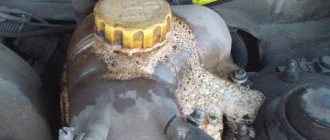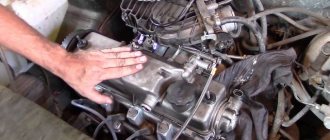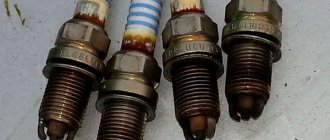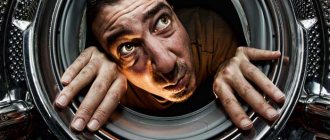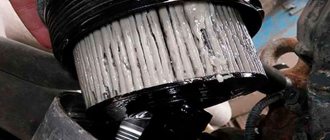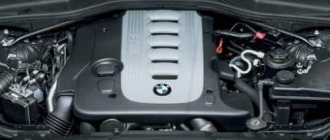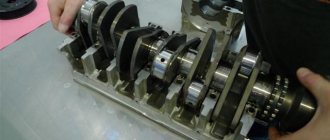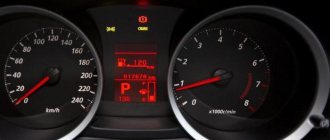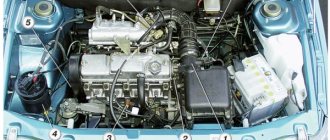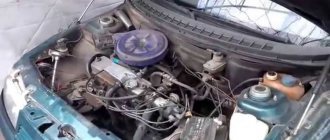A car smokes when cold, most often when the valve stem seals are worn, when piston rings are stuck, or when using an inappropriate viscosity or simply low-quality engine oil. For diesel engines, this can be a symptom of problems with the glow plugs, with the fuel system (high pressure pump) and occurs when using off-season diesel fuel.
| Situation | Cause of smoke when cold |
| Smokes when starting cold |
|
| Smokes when cold and then stops |
|
| Smokes white smoke when cold |
|
| Smokes blue when cold |
|
| Smokes black smoke when starting cold |
|
Main reasons
In such a situation, the presence of color in the exhaust indicates different engine conditions. Blue color means that oil has penetrated into the engine cylinder.
Increased fuel consumption contributes to this situation.
- Often blue signals a malfunction of parts in the cylinders or pistons.
- During the inspection, it is important to check the areas directly adjacent to the cylinder.
- You also need to check the side planes and depths of the rings on the pistons.
- Difficulties here arise due to the sealing of the cracks, which is caused by too much oil entering the system.
A little contamination does not cause a noticeable failure of compression, but you will need to exclude this possibility if a thick bluish exhaust is detected.
The color scheme of white and blue in connection with excessive fuel consumption can also be a symptom of a violation of the tightness of the valves and breakdowns in the ignition. New cars produce such smoke, but it gradually disappears, then there is no need to worry.
How to make calculations and assess the condition of the lubrication system
What to do if the engine still takes oil? Firstly, you need to accept as a fact that absolutely all internal combustion engines will consume it. This is the mechanism of their work, and we cannot change anything here. The fact is that the lubricant is forced to constantly circulate through the system, so losses are inevitable.
The greatest losses relate specifically to the piston group, since it accounts for the maximum friction of the parts. If you do not provide it with lubrication, the engine life will automatically decrease. But this is not the only reason. After all, this place is the hottest in the entire engine, which leads to oil combustion with the simultaneous formation of slag deposits on the valves and rings.
For modern cars, there are established calculations for how much oil the power unit consumes. This is related to fuel consumption, for example, if a car uses several liters of gasoline for every 100 kilometers traveled, then consuming 10 grams of oil will also be acceptable. That’s why they say that a liter of lubricant consumed per 10 thousand mileage is quite normal. In fact, even a couple of liters will not be critical.
If this indicator is higher, it means that there are definitely some problems with the engine. Usually, the situation does not suddenly get out of control, that is, the symptoms of eating oil begin to appear in advance. Most often this looks like small leaks at the joints, and later develops into spots on the asphalt in the crankcase area.
What does the color of exhaust smoke mean?
This manifestation is considered normal if the engine is started cold. If the smoke thickens, then diagnostics need to be done. In fact, the exhaust is a mixture of carbon dioxide, water vapor and nitrogen.
- When the engine and other components are working properly, the exhaust is colorless.
- A whitish tint appears when condensation or malfunction occurs.
- In the morning during frosty times or when there are clouds in the sky, moisture can accumulate. This steam is soon removed.
If it hangs like a thick cloud, then it’s worth checking the engine. Whitish smoke from the exhaust of a gasoline engine may occur due to leakage of coolant or antifreeze.
To confirm this theory, you should lean a white piece of paper against it. Grease stains will indicate a leak. Antifreeze can leak when cracks are created in the cylinder.
The engine gets very hot
It is worth noting that a carburetor engine encounters this problem much less often than an injection engine. Even on hot summer days it holds the temperature well and does not exceed 96 degrees. Why does the engine get hot?
- The thermostat malfunctions. As they say, the valve “caught the wedge.” This can be checked very simply: you need to touch the bottom of the thermostat with your hand. If it is cold, then the problem is in the thermostat valve. Another sign of a non-working thermostat: the radiator outlet is very overheated. As a result, this valve is kept closed, the liquid does not enter the radiator and boils. If in this state it penetrates into the piston part, as well as into the oil sump, this can lead to critical engine failure. Therefore, if a malfunction is detected, you need to turn off the engine and replace the thermostat with a working one.
- The appearance of an air lock in the radiator pipes. To eliminate this problem you will have to bleed the entire system.
- The radiator is clogged. To avoid this problem, you need to clean the radiator regularly, especially during the hot summer season. You also need to use only high-quality coolant to avoid clogging the radiator from the inside.
- You can also pay attention to whether the fan is broken.
- Another common reason that the VAZ 2106 engine may overheat is a breakdown of the water pump. Often there is a leak in the pump. You can check the operation of this part as follows: at engine operating temperature, sharply squeeze the inlet pipe on the radiator. In this case, the working pump produces a noticeable pulsation. It also doesn’t hurt to check the pump seal, which starts to leak from time to time.
How to check
The verification process here is carried out according to the following procedure:
- The tank plug is removed.
- The engine starts.
- The planes are visible for the presence of greasy marks.
- Sniffing the tank, if the exhaust smells burnt or stinky, this is a bad sign.
When a burning smell occurs, do not hesitate to check. It should be taken into account that the appearance of a whitish exhaust when rapidly pressing the accelerator pedal is often caused by burnout of the cylinder head gasket; the following aspects lead to this:
- Installation error;
- Significant overheating of the motor;
- Distortion of head elements;
- Constant movement at high speeds.
The light bluish tint of smoke from the exhaust of a gasoline engine and its injector is resolved due to cleaning. In certain situations, it may be necessary to change the sensors or pump.
When there are concerns about a breakdown, it is best to ask professional craftsmen for help. It is difficult to do this with your own hands, without the necessary skills.
When a lot of whitish smoke comes out of the exhaust as you move. In addition to other reasons, there may be a leak of the coolant that enters the crankcase container and mixes with the oil there. You can take a dipstick for testing; if the substance is white, you need to act urgently: find and remove damage, change the oil.
Why does it smoke when cold?
It happens that smoke appears during startup due to breakdowns in one engine unit, which arose due to faults in another part of the engine. For example, if the power unit has poor cooling and experiences constant overheating, then the piston rings burn.
In other cases, the engine smokes due to:
- power supply system failure;
- ignition faults;
- destruction of the cylinder-piston group;
- breakdown of the distribution mechanism.
Of course, only an experienced mechanic will determine the exact cause of the problem, so I always advise those who have little knowledge of engines to contact a service station in any case when the car begins to behave strangely. This will save you from further problems with it and high financial expenses.
The engine emits white smoke
White smoke is more like steam. Therefore, when you turn on the power plant, if the engine floats with a whitish, almost transparent steam, especially in winter, then there is no need to worry. When the engine starts to warm up, there is still condensation in the exhaust pipe. When it heats up, the moisture begins to warm up and evaporate. Therefore, you may notice whitish steam coming out.
Attention! When the temperature outside drops below 20 degrees, this white steam can become thick.
If the engine emits white smoke when you start the car in the summer season, then something is happening inside the engine, most likely there is a malfunction. Perhaps the CPG is suffering. This is where antifreeze comes in. This phenomenon indicates a leak in the rubber covering the cylinder head.
Water from the cooler does not evaporate quickly. This causes the appearance of white exhaust gases. By the way, when it comes out of the exhaust pipe and dissolves in the atmosphere, you can see a small bluish cloud.
To check on your own without contacting service whether the problem lies in a broken gasket, you need to open the radiator neck. If you smell the exhaust fumes and see a film of grease on the surface of the antifreeze, then the problem is indeed in the gasket.
The engine emits blue smoke
When the engine emits blue smoke, the cylinders are broken. Only now the bluish smoke indicates that lubricant has entered the cylinders, and not antifreeze. This kind of smoke, also called oily, can be of the following shades:
Similar article: Is it possible to add another brand of oil to the engine?
- bright blue;
- Navy blue.
If your car emits bluish smoke when cold, you should immediately take the car in for repairs. Since further driving will only be to the detriment of the engine.
Attention! How to distinguish bluish smoke from steam, which also leaves a bluish cloud: the bluish cloud does not dissipate after it leaves the chimney. And there is one more problem. Nowadays, many engines have converters that remove lubricant from the exhaust gases. This is bad because the car owner will not be able to see the symptoms of the vehicle's illness and drive it until the engine knocks.
You can only check by placing paper near the pipe outlet with the motor turned on recently. With the gas from the exhaust, drops of unburned lubricant will fall onto the sheet.
The engine smokes black smoke
If the power plant smokes black, then the combustible mixture is highly enriched. And, if high enrichment occurs, then there is a breakdown in the fuel supply system. When the engine smokes black, there is usually also excessive fuel consumption. The engine is difficult to start and sometimes stalls after starting. The car loses its former power.
In carburetor power units this happens due to overkill in the float chamber. In such engines, the needle valve has some kind of malfunction and does not work adequately.
Most often, car owners simply have a clogged air filter device. In this case, the engine smokes black. They come to a car service when the problem begins to worsen.
The engine smokes white smoke with a blue tint
If the power plant smokes whitish with a blue tint, then the fault lies in the valve stem seals. The parts become dull and do not perform their function. Another reason may be faulty oil scraper rings. They usually wear out and become stuck and do not perform their function.
When the engine emits blue smoke, the lubricant most often begins to burn. As for turbocharged engines, the problem lies in the breakdown of the turbocharger. There may also be problems with crankcase gas recirculation. Usually it gets clogged.
How to perform engine diagnostics
It is possible to more accurately identify a faulty cylinder using further methods:
- Unscrew the spark plugs and determine their condition. Coolant can wash out the spark plug in a broken cylinder;
- The crankshaft is adjusted so that the intake and exhaust valves are closed. Then you should give compressed air through the hole in the spark plug, then look into the expansion tank. An increase in the amount of coolant after air supply will indicate damage to the cylinder;
- The cylinder head is removed to check the gasket and the adjacent plane of the head. When no violations are found, then the tightness of the head is checked under pressure;
- The cylinder is being diagnosed. The piston should be lowered to BDC and the walls should be inspected for the presence of cracks;
- The intake manifold gasket is checked. This is done when in a separate engine such a gasket acts as a seal to the coolant circulation channels.
Diagnostic methods for the appearance of suspicious exhausts
It is important to understand why the exhaust pipe smokes when starting the engine and then stops. The easiest and best way to find out is to take a napkin. If its surface remains relatively clean under the exhaust, then there is no problem.
The car smokes when cold
Other options:
- oil traces - oil leak;
- sour smell and colored spots - coolant leak;
- oil stains indicate incompletely burnt fuel.
When visually inspecting parts, consider the engine design. The problems with gasoline systems are approximately the same, but the operating principles of the injector and carburetor are different. The former is more picky about the quality of the fuel used, and the latter is sensitive to temperature changes.
A visual inspection will help diagnose why the problem occurred:
- presence of an oily film on antifreeze;
- there is a smell of carbon monoxide coming from the expansion tank;
- the contents of the container have changed color/consistency or contain many small bubbles.
Start the car and check the oil and antifreeze levels. If they begin to change, then there is a leak in the system. A similar conclusion can be drawn when pressure changes. For complete diagnostics and troubleshooting, you should contact a service center.
Causes of smoke formation
A large output of gases from the muffler is a consequence of an incorrect balance between fuel and air, non-simultaneous or incomplete combustion of the mixture, or the leakage of antifreeze or oil into the engine cylinders.
The main reasons for the release of a large volume of smoke from a vehicle can be described as follows:
- Cooling system malfunctions;
- Wear of parts of a set of cylinders and pistons;
- The appearance of breakdowns in the fuel system;
- Unregulated operation of the gas distribution system.
Experienced mechanics can help you find out exactly why your car is smoking excessively by looking at the color of the exhaust. When the reason is clear, then it is much easier to resolve it. The appearance of gray, whitish, black smoke often occurs with other difficulties:
- High consumption of oil, gasoline or diesel fuel;
- Difficulty starting a cold engine;
- Engine operation intermittently at idle and under load;
- Loss of machine power.
It happens that smoke from the exhaust is the only symptom of a malfunction of some part of the car.
Why is black smoke dangerous when accelerating?
Diesel smokes black smoke in the case of an over-enriched mixture, when the air entering the cylinders is not enough for complete combustion of the injected portion of fuel. Often, thick black smoke is observed during sudden throttle changes, intense acceleration, or when driving under load. The main reasons for increased smoke:
- Insufficient air entering the intake manifold. A lack of oxygen can be caused by a clogged air filter, a leak in the intake tract, or a malfunction of the turbocharger.
- Excessive fuel supply. Most often, the cause of overflow lies in faulty injectors, but a similar situation is possible in the event of improper operation of the mass air flow sensor or absolute pressure sensor (DBP). If the sensor readings do not correspond to the actual amount of air entering the intake tract, the ECU (Engine Control Module) is not able to select the correct amount of fuel. The mixture turns out to be over-enriched, which is why black exhaust from the diesel engine is observed.
- Changing the timing and duration of fuel injection. The reason may be either faulty injectors or control. The timing of injection and the duration of the open state of the injectors can be affected by incorrect operation of the sensors that record the load on the engine (mass air flow sensor, DBP, gas pedal position sensor), as well as changes in the ECU firmware. When chip tuning, changes to the fuel map are made intentionally to increase the power of the diesel engine.
- EGR valve stuck in open position. Incomplete blocking of the exhaust gas return channel leads to a decrease in temperature in the combustion chamber. If the EGR valve does not close completely under full load, the air-fuel mixture does not burn completely and black smoke comes out of the pipe.
- Low quality diesel fuel.
- Incorrect installation of timing marks.
A general violation of the cyclic fuel supply or uneven fuel supply between the cylinders leads to increased loads on the parts of the cylinder-piston group, the crankshaft and its liners. Significant overflow can destroy the piston partitions and cause scuffing on the liners, which will subsequently lead to them turning over.
Rich white smoke from the exhaust
It differs from steam not only in its high density. When white smoke comes out of a car, it does not dissipate soon. At the same time, a burning smell is felt that does not go away after the engine reaches operating temperature.
Milky smoke indicates serious problems in the cooling system - antifreeze has entered the oil. The color scheme of the exhaust depends on the type of antifreeze.
The reasons for this violation:
- Violation of the cylinder head tightness - the appearance of cracks, large distortion or burnout of the gasket;
- Use of poor quality coolant and clogged cooling system. Poor quality antifreeze can eat through metal, greatly increasing corrosion, which may result in the impossibility of using some parts of the cooling system.
When antifreeze is mixed with oil, the lubricant loses its properties and becomes less viscous, which negatively affects the good performance of all parts of the engine and leads to a reduction in its working life.
Lack of compression in a diesel engine
If the spark plugs are in order and the damage has not disappeared, you should take a closer look at the cylinders themselves. It is quite possible that the gaps between individual elements in the piston system of your engine are greatly increased. Increasing the gaps between parts is a natural process when operating a car. But it also affects the compression of the engine cylinders.
Low pressure in the combustion chamber leads to the fact that the incoming fuel is not produced, but is ejected from the cylinder. Most often, the wear of engine parts occurs unevenly; the cylinders begin to operate with different degrees of compression. That's why the diesel engine stalls when cold and produces white smoke.
When warmed up well, the tripping becomes less noticeable or disappears completely, since engine parts tend to expand when heated. To find out whether the cause of tripping is reduced compression, you need to measure the pressure level with a special device - a pressure gauge.
What to do first
First, you need to carefully inspect the spark plugs when there is scale on them - this is a sign of water penetration into the cylinders.
- The cap of the expansion tank of the cooling system opens. A low level of antifreeze, an oil film, and a burning smell indicate a broken seal in the cooling system.
- You should remove the head and check the integrity of the gasket and the presence of cracks.
- All repair work must be carried out in a special auto workshop.
The influence of the quality of the oil used on smoke formation
Motor oil must have certain characteristics. The quality of the lubricant used directly depends on its properties. If the car engine contains low-quality oil, the viscosity coefficient of which does not correspond to the car brand, or if the temperature inside the engine increases, a sharp loss of useful properties of the lubricant occurs, this leads to serious damage to the elements and systems of the power unit. If blue smoke appears, you need to check the oil for compliance and, if necessary, completely replace it.
The appearance of smoke can be caused by a number of other reasons - from the appearance of microcracks in the engine body to the use of the wrong type of fuel intended for a given engine brand. Each specific situation always has a solution when seeking help from qualified specialists.
Good day to all!
The following problem arose: while driving, the engine began to stall, and after 2 minutes it started up. At the same time it smokes white. I unscrewed the spark plugs and the first cylinder spark plug was covered in oil.
What I did: 1) Replaced the spark plugs 2) Replaced the wires 3) Opened the cap of the expansion tank, revved it up, no bubbling. Therefore, I don't think about a cylinder head gasket.
Photo of how a gasoline engine smokes
SAMSUNG
Benefits and harms for the engine from using additives in the engine to reduce oil consumption
Let's start with the positive aspects. It has been repeatedly tested and proven that engine additives are capable of protecting the engine from wear for some time, that is, creating that same protective layer.
- The additive can be used if there is a critical drop in the oil level without the possibility of topping up or stopping the car (for example, the oil pan was broken on the highway and you need to get to a nearby car service station under your own power).
- Also, in some cases, an engine additive can extend the life of an old, worn-out engine, which is almost impossible to operate normally without repair. To put it simply, the additive allows you to delay the time before major repairs, while at the same time allowing the owner not to add about 0.5-1.0 liters of oil every 100-200 km. mileage, switch to cheaper oil and thereby save money.
Now let's focus on the cons. The most important disadvantage of using additives to reduce oil consumption is the short-term (often very short-term) positive effect, as well as unpredictable consequences for the internal combustion engine after using such compounds. The latter become obvious after opening the engine for a major engine overhaul.
- auto mechanics note that after using anti-wear additives, the “insides” of the engine are often covered with a certain layer, which is extremely difficult (and sometimes even impossible) to wash.
- There are individual statements that after using certain compounds, parts cannot be restored (grinding, boring, etc.) during engine repairs. This means that such elements (often expensive) require mandatory replacement.
- Repairing an engine that regularly uses protective solutions or additives to reduce oil consumption typically costs 20-50% more than engines that do not use these compounds.
